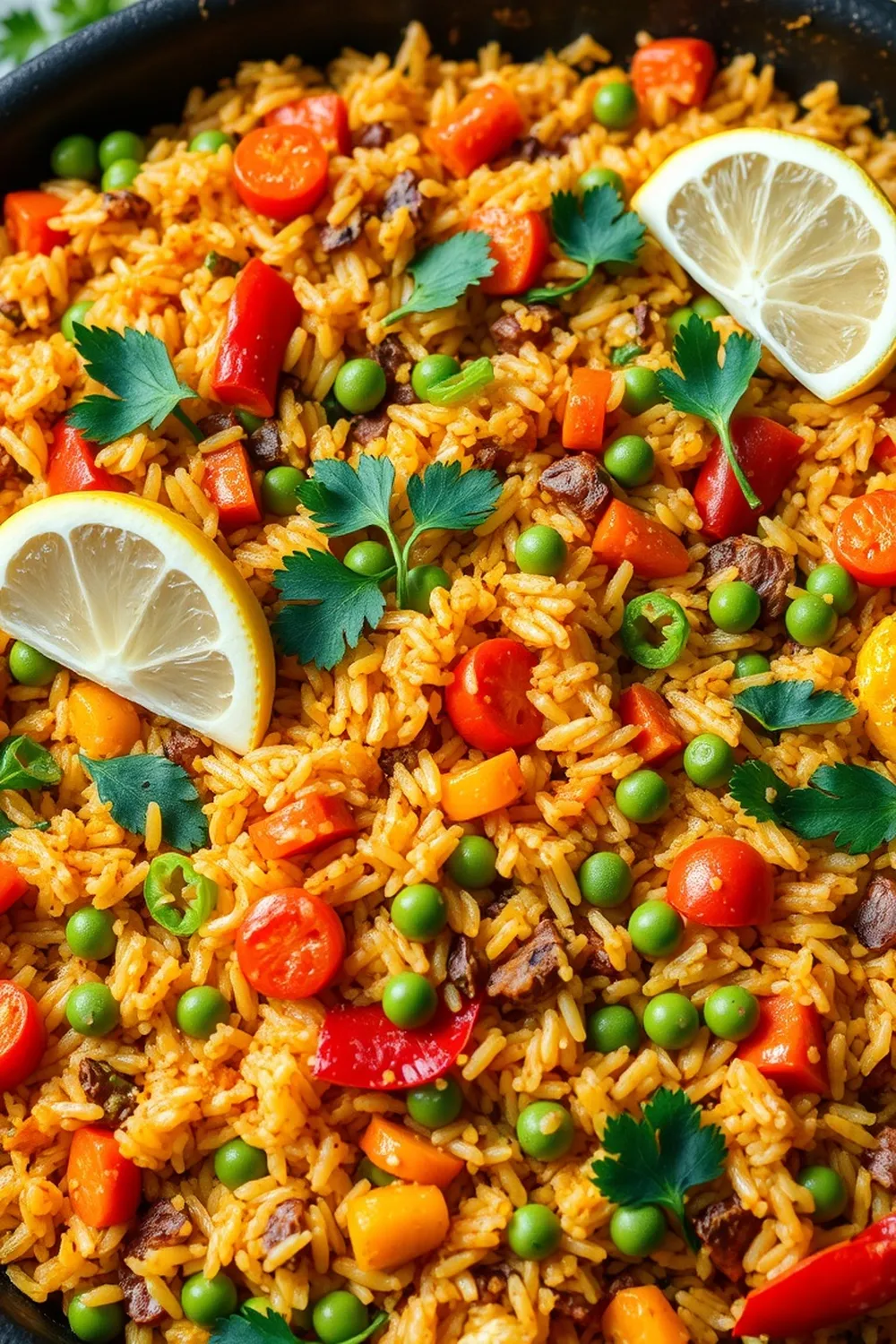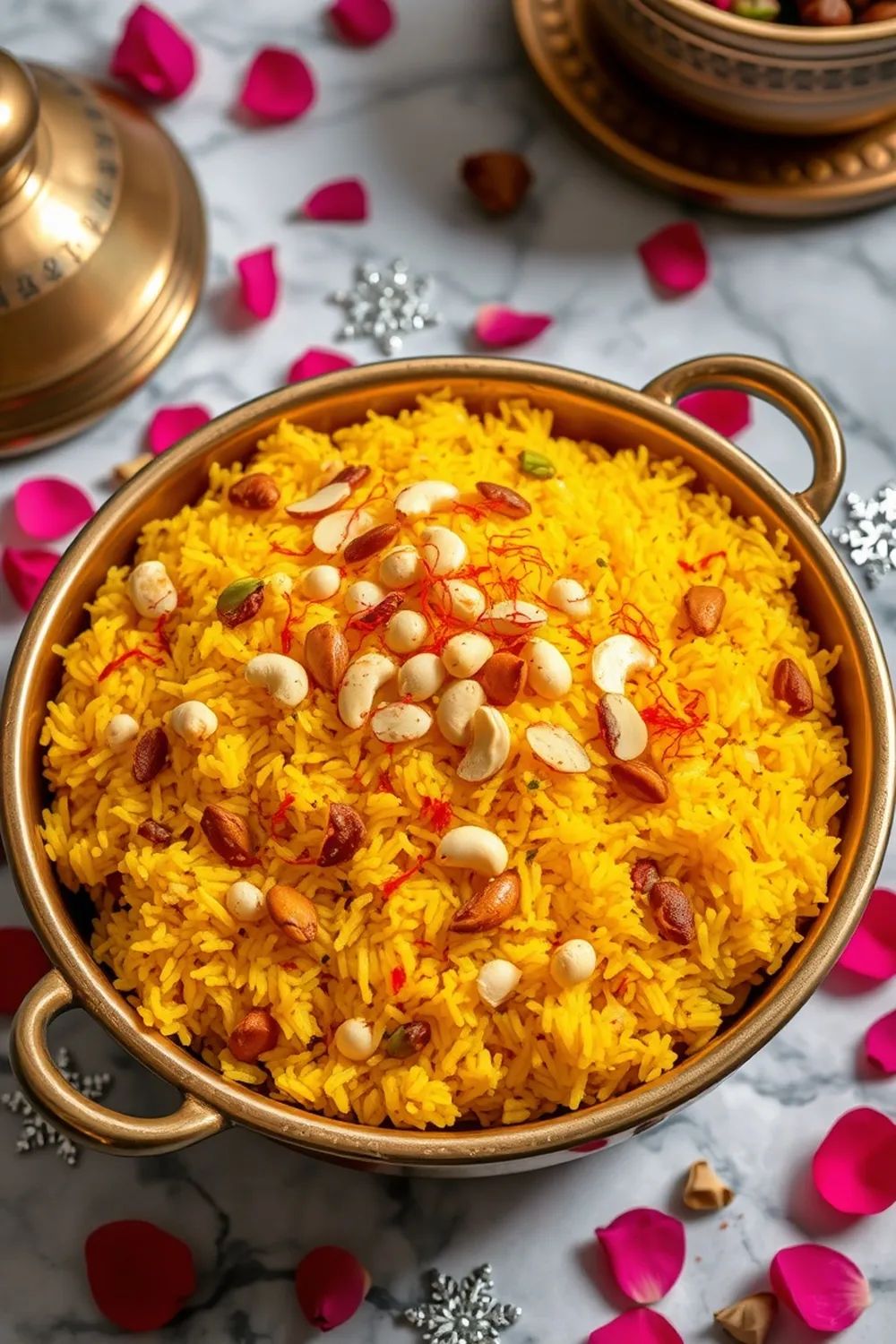- Prepare saffron water by crushing saffron strands and 1/4 tsp sugar into a powder. Mix with 1/4 cup hot water and set aside.
- Soak basmati rice for 30 minutes, then drain.
- Boil 10 cups of salted water. Add rice and parboil for 5-7 minutes. Drain and rinse in cold water.
- Clean barberries, drain, then sauté in 2 tbsp butter with 1 tsp sugar until puffed. Add 2 tbsp saffron water and mix.
- Heat a saucepan, add 3 tbsp olive oil and 2 tbsp saffron water. Layer sliced potatoes at the bottom for tahdig (crust).
- Layer half the rice over potatoes, spread barberries, then add remaining rice. Create steam holes in the rice.
- Cook on high heat for 5 minutes. Reduce heat to low, sprinkle remaining saffron water over the rice, cover lid with a cloth, and steam for 30-45 minutes.
- Gently mix rice before serving, ensuring the crispy potato tahdig remains intact.
- Calories:350 kcal25%
- Energy:1464 kJ22%
- Protein:6 g28%
- Carbohydrates:65 mg40%
- Sugar:10 mg8%
- Salt:200 g25%
- Fat:8 g20%
Last Updated on 4 months by Neha Deshmukh
Zereshk Polo Recipe – Authentic Persian Barberry Rice with Tahdig
Hello friends! Today, I’m sharing a recipe that’s incredibly close to my heart – Zereshk Polo. This isn’t just rice; it’s a celebration on a plate! I first made this for a Nowruz gathering with some Persian friends, and let me tell you, the smiles were huge. It’s a bit of a project, but trust me, the fragrant, fluffy rice studded with tart barberries and that glorious crispy tahdig (the golden crust!) is so worth it. Let’s get cooking!
Why You’ll Love This Recipe
Zereshk Polo is a beautiful harmony of flavors and textures. The sweetness of the saffron, the tartness of the barberries, and the comforting base of basmati rice… it’s a truly special dish. Plus, the tahdig? Forget about it! It’s the most coveted part of the meal. It’s perfect for special occasions, but honestly, I make it whenever I want a little bit of sunshine on my plate.
Ingredients
Here’s what you’ll need to create this Persian masterpiece:
- 2 cups basmati rice (about 300g)
- 1 cup barberries (zereshk) (about 150g)
- 1 tbsp butter (14g)
- 1 tsp sugar (4g)
- 2-3 tbsp olive oil (30-45ml)
- 2 potatoes, medium sized
- 10 strands of saffron
- ½ tsp sugar (2g)
- ½ cup hot water (120ml)
Ingredient Notes
Let’s talk ingredients – a few tips to make sure everything comes together beautifully!
Basmati Rice: Choosing the Right Grain
Basmati is key here. Look for long-grain basmati rice, preferably aged. Aged basmati tends to be fluffier and less sticky. I usually get mine from an Indian grocery store, and it makes all the difference.
Barberries (Zereshk): A Unique Tart Flavor
Barberries are what give Zereshk Polo its signature tang. You can find them dried at Middle Eastern or Indian grocery stores. Don’t skip these – they’re essential!
Saffron: The “Red Gold” of Persia
Saffron is expensive, yes, but a little goes a long way. It provides that beautiful color and delicate flavor. Don’t skimp if you can help it!
Butter: Ghee vs. Regular Butter – Regional Preferences
Traditionally, ghee (clarified butter) is used, especially in some regions of Persia. It adds a lovely nutty flavor. But regular butter works perfectly well too! I often use regular butter for convenience.
Potatoes: Best Varieties for Tahdig
Waxy potatoes like Yukon Gold or red potatoes work best for the tahdig. They hold their shape well and get beautifully crispy. Russets can work in a pinch, but they tend to fall apart more easily.
Step-By-Step Instructions
Alright, let’s get cooking! Don’t be intimidated – I’ll walk you through it.
- First, let’s make that gorgeous saffron water. Crush the saffron strands with ½ tsp of sugar into a powder. Pour in the hot water and let it sit. This will bloom the saffron and release its color and flavor.
- Now, soak the basmati rice in water for about an hour. This helps it cook evenly and become nice and fluffy. After an hour, drain the rice well.
- Bring 10 cups of salted water to a boil. Add the drained rice and parboil for 5-7 minutes. You want the rice to be partially cooked – still firm to the bite. Drain the rice again and rinse it with cold water to stop the cooking process.
- Time for the barberries! Clean them and drain well. Melt the butter in a pan, add 1 tsp of sugar, and sauté the barberries until they puff up. Add 2 tbsp of the saffron water and mix well. Set aside.
- Heat a saucepan (a heavy-bottomed one is best!) with 2-3 tbsp of olive oil. Slice the potatoes thinly and arrange them at the bottom of the pot to create the tahdig.
- Layer half of the parboiled rice over the potatoes. Sprinkle the sautéed barberries evenly over the rice. Then, add the remaining rice.
- Using the handle of a wooden spoon, create a few steam holes in the rice. This helps the steam escape and prevents the rice from becoming mushy.
- Cook on high heat for about 5 minutes. Then, reduce the heat to low, sprinkle the remaining saffron water over the rice, and cover the pot with a lid. Wrap a clean kitchen towel around the lid to absorb excess steam.
- Steam for 30-45 minutes. Resist the urge to peek!
- Gently fluff the rice with a fork before serving, being careful not to disturb the crispy potato tahdig at the bottom.
Expert Tips
Here are a few things I’ve learned over the years to help you nail this recipe:
Achieving the Perfect Tahdig (Crispy Rice Crust)
A heavy-bottomed pot is essential for a good tahdig. The even heat distribution prevents burning. Also, don’t be afraid to let it get really golden brown – that’s where the flavor is!
Mastering the Rice Parboiling Technique
The parboiling step is crucial. You want the rice to be partially cooked but still firm. This ensures it doesn’t turn to mush during steaming.
Saffron Water Preparation – Maximizing Color and Flavor
Crushing the saffron strands helps release their color and flavor. Letting it sit in hot water allows it to bloom properly.
Avoiding Sticky Rice: Key Techniques
Soaking the rice, rinsing it after parboiling, and creating steam holes are all key to preventing sticky rice.
Variations
Want to put your own spin on things? Here are a few ideas:
- Vegan Zereshk Polo: Substitute the butter with vegan butter or olive oil.
- Gluten-Free Zereshk Polo: This recipe is naturally gluten-free!
- Spice Level Adjustment (Adding a Hint of Heat): My friend, Zara, adds a pinch of cayenne pepper to the barberry mixture for a little kick. It’s delicious!
- Nowruz (Persian New Year) Adaptation: Traditionally, Zereshk Polo is served as part of the Nowruz spread, symbolizing prosperity and happiness.
Serving Suggestions
Zereshk Polo is traditionally served with roasted chicken or lamb. It also pairs beautifully with fish or a simple vegetable stew. A side of yogurt (mast-o-khiar) is always a welcome addition.
Storage Instructions
Leftover Zereshk Polo can be stored in an airtight container in the refrigerator for up to 3 days. Reheat gently in a saucepan with a splash of water to prevent it from drying out. The tahdig won’t be as crispy, but it will still be delicious!
FAQs
Let’s answer some common questions:
What is Zereshk Polo traditionally served with?
Traditionally, it’s served with roasted meats like chicken or lamb, but it’s versatile and goes well with fish or vegetarian dishes too.
Can I use frozen barberries instead of dried?
While dried barberries are preferred for their intense flavor, you can use frozen ones in a pinch. You might need to adjust the cooking time slightly.
How can I tell when the Tahdig is perfectly crispy?
Gently lift the edge of the rice with a spatula. If it’s golden brown and releases easily from the pot, it’s ready!
What if I don’t have a heavy-bottomed pot for making Tahdig?
A cast iron pot is a great alternative. If you don’t have either, use the thickest-bottomed pot you have and keep a close eye on it to prevent burning.
Can Zereshk Polo be made ahead of time?
You can parboil the rice and prepare the barberry mixture ahead of time. But the final steaming and tahdig creation are best done just before serving.
Enjoy! I hope this recipe brings a little bit of Persian sunshine into your kitchen. Let me know how it turns out in the comments below!
Neha Deshmukh
Neha holds a B.A. in History with a focus on Indian and world history, including ancient, medieval, and modern periods. At RecipesOfIndia.org — the world’s largest database of Indian recipes — she combines her love for food and history by exploring how India’s past has shaped its culinary traditions.










